Project Keiko Part VII - Rotor Seals Assembly
#1
Project Keiko Part VII - Rotor Seals Assembly
---Edit: Here are the other chapters of the project, for easy reference---
Project Keiko - Helping a friend
Project Keiko Part II - Exterior, Seals, and Engine Bay Teardown
Project Keiko Part III - Engine Removals
Project Keiko Part IV - Tri-Engine Teardowns I
Project Keiko Part V - Tri-Engine Teardowns II
Project Keiko Part VI - Engine Build I
Project Keiko Part VII - Rotor Seals Assembly
Project Keiko Part VIII - Week Of Crazyness
Project Keiko Part IX - End of Season Update
Project Keiko Part X - Spring 2009 Update
Project Keiko Part XI - Another Engine, Ready to Start
Project Keiko Part XII - Up For Sale
---/Edit---
So despite some setbacks (ie: not realizing that the Atkins Rebuild Kit "A" didn't have oil control ring springs and having to order some) I got to assembling the rotors with all their seals and springs tonight.
After the engine teardowns, I spent a lot of time re-reading old threads that I had found pertaining to engine builds. One of the most informative that also had a metric ton of pictures was by Aaron Cake, as part of his Project Tina:
Pics and Status Of (Project Tina's) Turbo-NA-Brigeport Engine Build
The one thing he didn't do though was a step-by-step guide to the assembly of the rotors. I decided that despite how incredibly tedious it would be to wipe the oil and vaseline off my hands every 30 seconds to take another picture I would do the tutorial anyway since nobody had done one.
I covered my workspace with clean shop towels and laid everything out so I could be organized and be sure that I wasn't missing anything:

I separated my work space into four areas. Across the top was for the Front Face of both rotors, across the middle was for the Rear Face of both rotors, with the Front Rotor on the left side and the Rear Rotor on the right.
This is something you really have to make VERY sure you get correct. Here's what I did to make sure I didn't get messed up:
1. The rotors have "F" or "R" stamped into the combustion recess. Find those markings and put the rotors on their respective sides of the table
2. Think about how the engine will be assembled, and you'll realize that the Front Face of the Front Rotor has the gear, while the Rear Face of the Rear Rotor has the gear. Keep this in mind.
If ever you get stuck, picture the front iron sitting on the engine stand and you placing the front rotor onto it, meshing with the gear. Then think about how the rear rotor has to have its gear face up before you put the rear iron down on it to mesh with the rear stat gear
3. Place the Front Rotor gear-side down and the Rear Rotor gear-side up, and do both the Rear Faces first, then flip them over and do both the Front Faces. So when you look at your rotors, both should be showing the opposite side.
It's always a good idea to constantly do a mental check to make sure you're doing the right thing. The oil control ring springs are colour coded (Blue for Rear Face, white/cream for Front Face) so you need to make sure they end up on the right sides!
Here are the Seals/Springs for the Front Face (gear-side) of the Front Rotor (notice that the springs are coloured cream/white)

and here are the Seals/Springs for the Rear Face (non-gear-side) of the Front Rotor (notice that the springs are coloured blue)

Here's a picture of the Front Rotor, with its Rear Face showing

... and a picture of the Rear Rotor, with its Rear Face showing

Now if you're not completely confused by this point, let's move on. If you are, go spend some time looking at how the engine goes together in Aaron's thread for Project Tina above and pay close attention to where the stationary gears are, where the rotor gears are, and keep in mind that "front" of the engine always faces the floor. Then come back and we'll move on
Jon
Project Keiko - Helping a friend
Project Keiko Part II - Exterior, Seals, and Engine Bay Teardown
Project Keiko Part III - Engine Removals
Project Keiko Part IV - Tri-Engine Teardowns I
Project Keiko Part V - Tri-Engine Teardowns II
Project Keiko Part VI - Engine Build I
Project Keiko Part VII - Rotor Seals Assembly
Project Keiko Part VIII - Week Of Crazyness
Project Keiko Part IX - End of Season Update
Project Keiko Part X - Spring 2009 Update
Project Keiko Part XI - Another Engine, Ready to Start
Project Keiko Part XII - Up For Sale
---/Edit---
So despite some setbacks (ie: not realizing that the Atkins Rebuild Kit "A" didn't have oil control ring springs and having to order some) I got to assembling the rotors with all their seals and springs tonight.
After the engine teardowns, I spent a lot of time re-reading old threads that I had found pertaining to engine builds. One of the most informative that also had a metric ton of pictures was by Aaron Cake, as part of his Project Tina:
Pics and Status Of (Project Tina's) Turbo-NA-Brigeport Engine Build
The one thing he didn't do though was a step-by-step guide to the assembly of the rotors. I decided that despite how incredibly tedious it would be to wipe the oil and vaseline off my hands every 30 seconds to take another picture I would do the tutorial anyway since nobody had done one.
I covered my workspace with clean shop towels and laid everything out so I could be organized and be sure that I wasn't missing anything:

I separated my work space into four areas. Across the top was for the Front Face of both rotors, across the middle was for the Rear Face of both rotors, with the Front Rotor on the left side and the Rear Rotor on the right.
This is something you really have to make VERY sure you get correct. Here's what I did to make sure I didn't get messed up:
1. The rotors have "F" or "R" stamped into the combustion recess. Find those markings and put the rotors on their respective sides of the table
2. Think about how the engine will be assembled, and you'll realize that the Front Face of the Front Rotor has the gear, while the Rear Face of the Rear Rotor has the gear. Keep this in mind.
If ever you get stuck, picture the front iron sitting on the engine stand and you placing the front rotor onto it, meshing with the gear. Then think about how the rear rotor has to have its gear face up before you put the rear iron down on it to mesh with the rear stat gear
3. Place the Front Rotor gear-side down and the Rear Rotor gear-side up, and do both the Rear Faces first, then flip them over and do both the Front Faces. So when you look at your rotors, both should be showing the opposite side.
It's always a good idea to constantly do a mental check to make sure you're doing the right thing. The oil control ring springs are colour coded (Blue for Rear Face, white/cream for Front Face) so you need to make sure they end up on the right sides!
Here are the Seals/Springs for the Front Face (gear-side) of the Front Rotor (notice that the springs are coloured cream/white)

and here are the Seals/Springs for the Rear Face (non-gear-side) of the Front Rotor (notice that the springs are coloured blue)

Here's a picture of the Front Rotor, with its Rear Face showing

... and a picture of the Rear Rotor, with its Rear Face showing

Now if you're not completely confused by this point, let's move on. If you are, go spend some time looking at how the engine goes together in Aaron's thread for Project Tina above and pay close attention to where the stationary gears are, where the rotor gears are, and keep in mind that "front" of the engine always faces the floor. Then come back and we'll move on

Jon
Last edited by vipernicus42; 08-25-09 at 07:45 PM.
#2
First up are the Oil Seals.
The oil seals are rubber o-rings which fit inside metal carriers. We must remove the old seals carefully, lube up the new seals, and install them into the carriers equally as carefully.
Here is a picture of the original Inner Oil Seal. As you can see it has flattened into the carrier and doesn't have the elasticity it once did.

I gently pried it out with the tip of a knife, being careful not to nick or damage the carrier. That left me with an empty carrier, which I cleaned with a shop towel

Here's what the new inner oil seal looks like beside its carrier

It's a good idea to oil up the seal prior to install. They are after all oil seals, and everything should be well lubricated so that it moves freely.
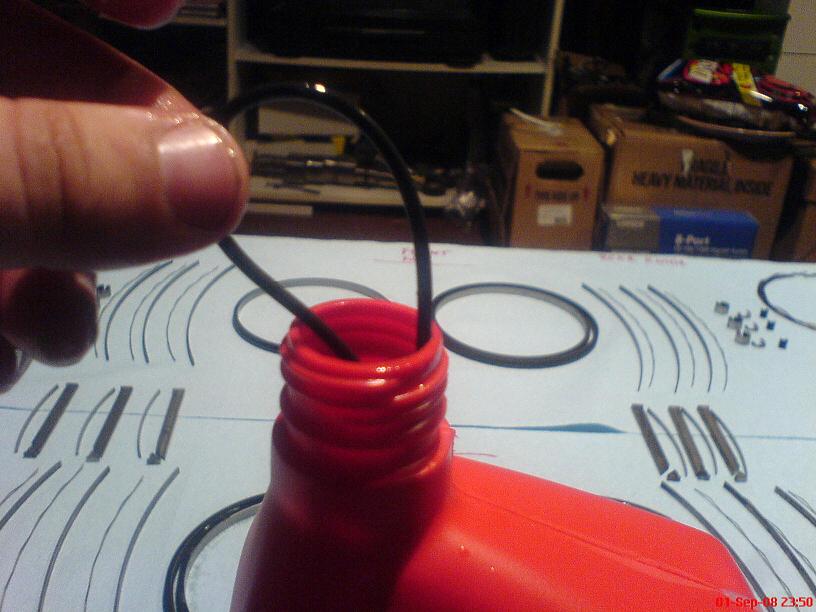
And here's what the new inner oil seal looks like after being installed into its carrier:

The oil seals are rubber o-rings which fit inside metal carriers. We must remove the old seals carefully, lube up the new seals, and install them into the carriers equally as carefully.
Here is a picture of the original Inner Oil Seal. As you can see it has flattened into the carrier and doesn't have the elasticity it once did.

I gently pried it out with the tip of a knife, being careful not to nick or damage the carrier. That left me with an empty carrier, which I cleaned with a shop towel

Here's what the new inner oil seal looks like beside its carrier

It's a good idea to oil up the seal prior to install. They are after all oil seals, and everything should be well lubricated so that it moves freely.

And here's what the new inner oil seal looks like after being installed into its carrier:

#3
The Outer oil seals are very similar, with the one difference being that they fit around the inside of their metal carriers instead of the outside.
Here is the original outer oil seal:

And the dirty carrier as it looked once the oil seal was removed, before I cleaned it with a shop towel:

The new Outer Oil Seal installed:

And a picture of all eight (four inner, four outer) oil seal carriers with their new seals installed:

I applied a generous dose of oil to the carriers and seals by dipping my thumb and index finger in oil and running each one through my fingers. More oil is better as it eases installation.
Here is the original outer oil seal:

And the dirty carrier as it looked once the oil seal was removed, before I cleaned it with a shop towel:

The new Outer Oil Seal installed:

And a picture of all eight (four inner, four outer) oil seal carriers with their new seals installed:

I applied a generous dose of oil to the carriers and seals by dipping my thumb and index finger in oil and running each one through my fingers. More oil is better as it eases installation.
#4
Turning my attention back to the rotors, I installed the first spring.
I decided to do the rears of both rotors first, so I took the blue-painted springs, made sure that it was indeed the REAR face of both rotors showing (non-gear side for the front rotor, gear-side for the rear rotor) and placed the spring in its groove.
Again, it's a good idea to pour a little oil into the groove and spread it around before installing the spring and oil seals/carriers.
The paint side faces up, which means that the rounded edge of the spring faces towards the body of the rotor. You want that rounded edge to fit into the little depression that's made to hold it in place. If you can't see it, running the tip of the knife along the groove will help you find it.
Here's the inner oil control spring in place on the Rear face of the Front rotor:

With the spring in place, the "flat" end of the spring points upwards at you. Pick up your Oil Seal and Carrier and find the little "notch" it has in one side. Line that notch up with the "flat" end of the spring and place it evenly on top of the spring.
It will take some work to get the Oil Seals in place. It's helpful if you have a spare Oil Seal carrier around. Sometimes you might be able to get it in just pressing with your fingers, but often it will take a little more persuasion. Don't be tempted to use a metal hammer, that could seriously damage the carrier. If you have a wooden or plastic hammer you can use it gently. I actually used the corner of the vaseline container in some cases, and in others I used a spare oil control ring and one of the faces of a spare rotor (I didn't mind beating up the spare control ring, just don't use it directly on the one you're trying to install)
After some work, the oil seal and its carrier sit snugly in their groove, just barely peeking above the surface. You should be able to press it with your finger and have it move freely up and down.
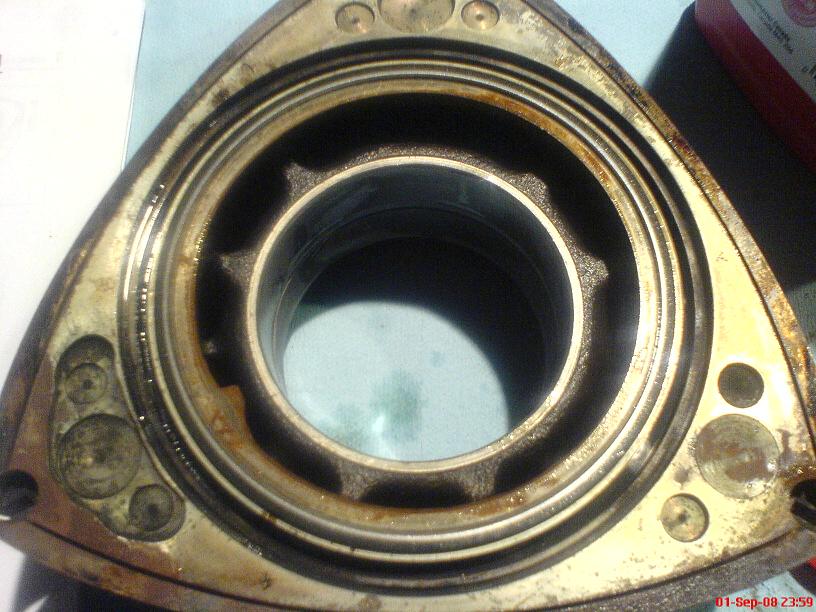
The process is the same for the outer seal, as well as the inner and outer seal on each other rotor face for both rotors. The only difference is that when you're doing the "Front" faces, you use the cream-coloured springs instead of the blue ones.
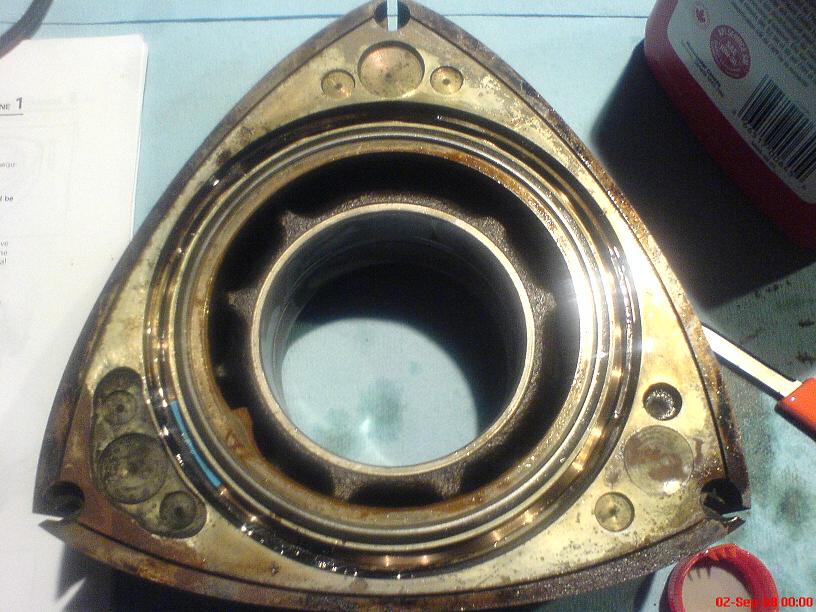

I decided to do the rears of both rotors first, so I took the blue-painted springs, made sure that it was indeed the REAR face of both rotors showing (non-gear side for the front rotor, gear-side for the rear rotor) and placed the spring in its groove.
Again, it's a good idea to pour a little oil into the groove and spread it around before installing the spring and oil seals/carriers.
The paint side faces up, which means that the rounded edge of the spring faces towards the body of the rotor. You want that rounded edge to fit into the little depression that's made to hold it in place. If you can't see it, running the tip of the knife along the groove will help you find it.
Here's the inner oil control spring in place on the Rear face of the Front rotor:

With the spring in place, the "flat" end of the spring points upwards at you. Pick up your Oil Seal and Carrier and find the little "notch" it has in one side. Line that notch up with the "flat" end of the spring and place it evenly on top of the spring.
It will take some work to get the Oil Seals in place. It's helpful if you have a spare Oil Seal carrier around. Sometimes you might be able to get it in just pressing with your fingers, but often it will take a little more persuasion. Don't be tempted to use a metal hammer, that could seriously damage the carrier. If you have a wooden or plastic hammer you can use it gently. I actually used the corner of the vaseline container in some cases, and in others I used a spare oil control ring and one of the faces of a spare rotor (I didn't mind beating up the spare control ring, just don't use it directly on the one you're trying to install)
After some work, the oil seal and its carrier sit snugly in their groove, just barely peeking above the surface. You should be able to press it with your finger and have it move freely up and down.

The process is the same for the outer seal, as well as the inner and outer seal on each other rotor face for both rotors. The only difference is that when you're doing the "Front" faces, you use the cream-coloured springs instead of the blue ones.


#5
With the oil control rings/seals and springs installed, the next on the list are the Apex Seals.
Vaseline is used in capricious amounts to hold everything in place. I still use a liberal dose of oil on all the springs, but for all the seals vaseline is the best thing to hold them in their spots until you assemble the engine.
Here's an apex seal

And here's what it looks like completely covered in vaseline

You want the flat side of the apex seal to point towards the "Front" face of each rotor. That way when you're putting the engine together, you put the rotor down Front-first, then install the apex seal spring and side piece before putting the next iron on.
You do want to make sure the apex seal has free movement in its groove, since you don't want it sticking or binding once the engine is built. Once you've confirmed it slides in its groove properly, hold it in place with more vaseline.
Here's the apex seal installed in its groove with lots of vaseline holding it in place
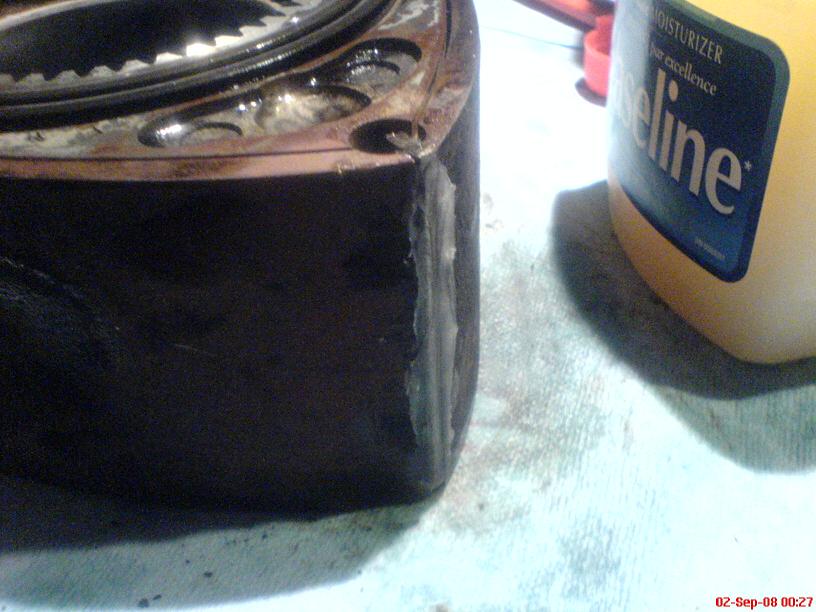
Next up are the corner seals. Each corner seal has a rubber insert which must be installed. I covered them in vaseline and slid them into place in the corner seals
Here is the corner seal beside its rubber insert

and here is what it looks like with the insert installed

Vaseline is used in capricious amounts to hold everything in place. I still use a liberal dose of oil on all the springs, but for all the seals vaseline is the best thing to hold them in their spots until you assemble the engine.
Here's an apex seal

And here's what it looks like completely covered in vaseline

You want the flat side of the apex seal to point towards the "Front" face of each rotor. That way when you're putting the engine together, you put the rotor down Front-first, then install the apex seal spring and side piece before putting the next iron on.
You do want to make sure the apex seal has free movement in its groove, since you don't want it sticking or binding once the engine is built. Once you've confirmed it slides in its groove properly, hold it in place with more vaseline.
Here's the apex seal installed in its groove with lots of vaseline holding it in place

Next up are the corner seals. Each corner seal has a rubber insert which must be installed. I covered them in vaseline and slid them into place in the corner seals
Here is the corner seal beside its rubber insert

and here is what it looks like with the insert installed

Last edited by vipernicus42; 09-11-08 at 01:58 PM.
#6
One thing that is nice about the Atkins Rotary rebuild kits is that even the cheapest budget kit (The "Rebuild Kit 'A'") have 3rd Gen corner seal springs which are a VAST improvement over the stock 12a corner seal springs. I threw all mine out more than a week before I took these pictures so I don't have one to compare but they're basically very small, thin pieces of wire bent into a similar shape to the ones you see here.
I oiled up the corner seal springs well and placed them in their respective spots.
Here's one of the corner seals all oiled up ready to be installed

And here's one installed in its spot (it's kind of hard to see, but it's there, with the opening towards the apex seal of course)

Now one thing you have to keep in mind is that the apex seal springs don't get installed now - they get installed after the rotor and its rotor housing are in place. If the apex seal springs were installed now, it would be nearly impossible to get the rotor housing in place over top of the rotor because the apex seals would be sticking out too far.
Why am I mentioning this now? Because if all of the corner seals were installed, we wouldn't be able to install the apex seal springs! The corner seals have to come out of the "rear" side of the rotor for the apex seal springs to slide down in place.
I chose to install all the corner seals anyway for two reasons. One, I wanted to make sure they all slid easily and comfortably into their spots, and Two, I wanted a good way to know where everything was since I won't be assembling the engine for at least 24-48hrs. When it comes time to assemble the engine I'll remove the corner seals from the "rear" side of the rotors, slide the apex seal springs in place, and reinstall the corner seals along with the apex seal side pieces.
Here's what the corner seal looks like when it's installed in its spot:
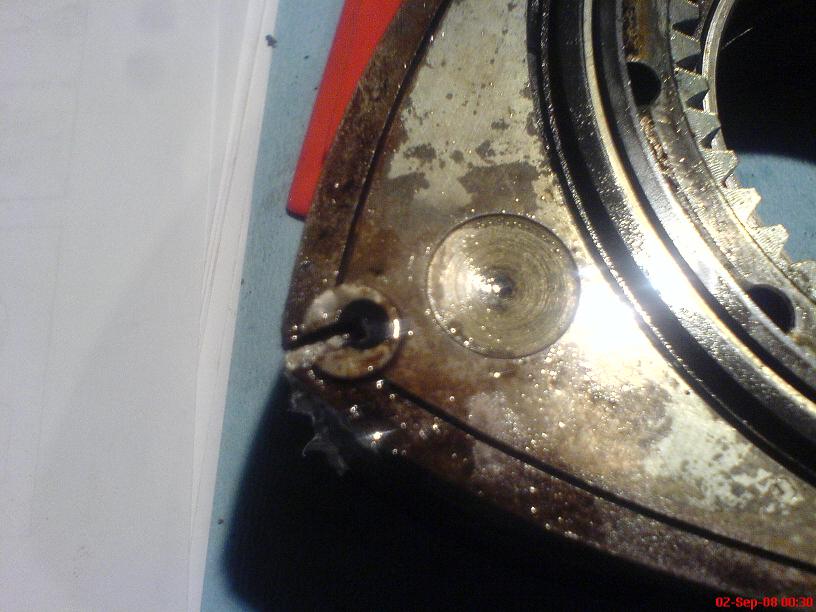
And here is one rotor with all of its corner seals installed:

I oiled up the corner seal springs well and placed them in their respective spots.
Here's one of the corner seals all oiled up ready to be installed

And here's one installed in its spot (it's kind of hard to see, but it's there, with the opening towards the apex seal of course)

Now one thing you have to keep in mind is that the apex seal springs don't get installed now - they get installed after the rotor and its rotor housing are in place. If the apex seal springs were installed now, it would be nearly impossible to get the rotor housing in place over top of the rotor because the apex seals would be sticking out too far.
Why am I mentioning this now? Because if all of the corner seals were installed, we wouldn't be able to install the apex seal springs! The corner seals have to come out of the "rear" side of the rotor for the apex seal springs to slide down in place.
I chose to install all the corner seals anyway for two reasons. One, I wanted to make sure they all slid easily and comfortably into their spots, and Two, I wanted a good way to know where everything was since I won't be assembling the engine for at least 24-48hrs. When it comes time to assemble the engine I'll remove the corner seals from the "rear" side of the rotors, slide the apex seal springs in place, and reinstall the corner seals along with the apex seal side pieces.
Here's what the corner seal looks like when it's installed in its spot:

And here is one rotor with all of its corner seals installed:

Last edited by vipernicus42; 09-11-08 at 01:59 PM.
#7
Lastly, we have the Side Seals and their Springs.
Oil up the side seal and insert it into its groove. Side Seal grooves are slightly different lengths for each side of each rotor in existence due to the way rotors are made (cast?). The side seal springs are purposefully made shorter than any side seal groove could possibly be, so it's not a concern for the springs, but it is an issue for the side seals themselves
Side Seal Spring Oiled Up
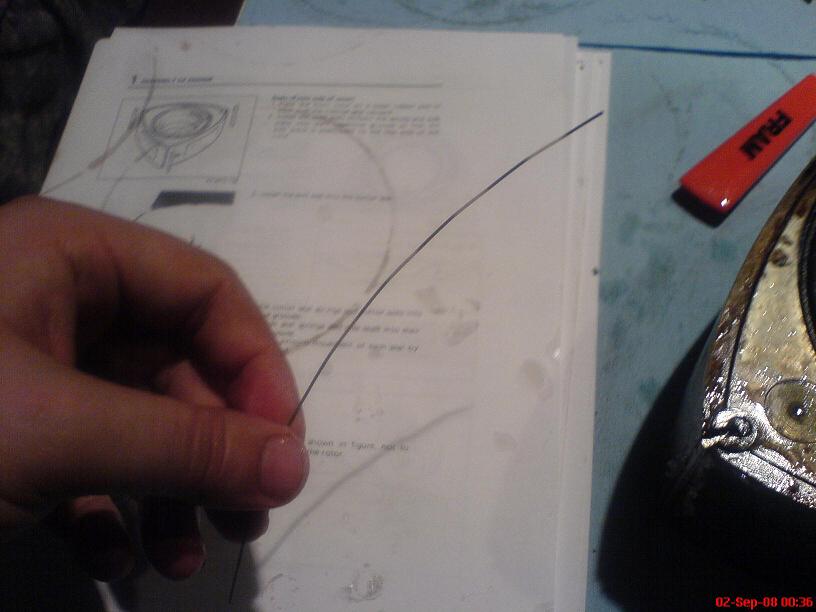
Side Seal Spring Installed
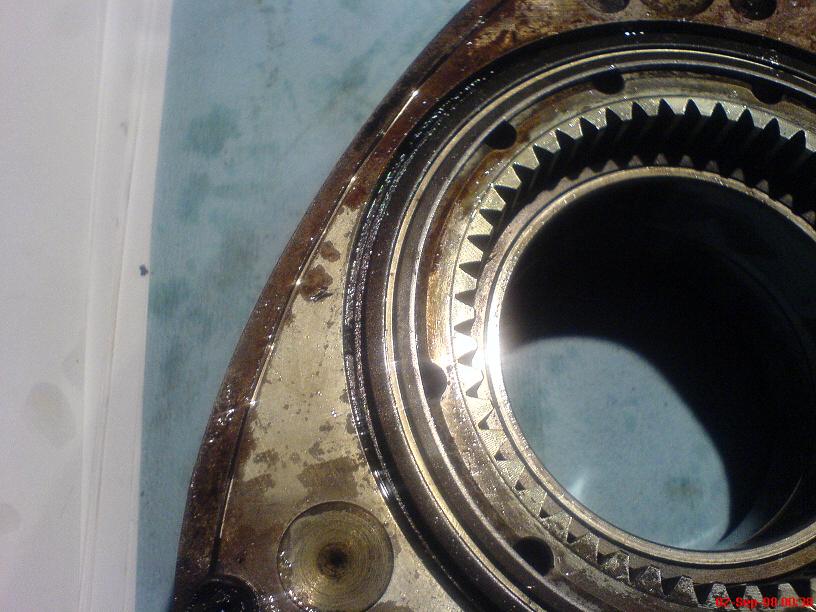
The side seals themselves should be clearance, or if you're re-using your side seals on a rebuild, you should have stored them in a compartmented box where each side of each face of each rotor was kept track of. New side seals are made longer than any side seal groove should be and have to be filed down to fit their groove. Old ones should be placed back in exactly the same groove they were removed from.
In this case, I tore apart three engines, broke a *bunch* of side seals that were seized into their grooves, and didn't keep track of which grooves the intact ones came out of. The result is that some of these side seals may not be properly clearanced for their grooves. This will mean that I will have lower compression on some rotor faces than I would like, since combustion gasses will leak past the side seal in the tenths-of-a-millimetre worth of clearance gap there is between the side seal and the corner seal. For this budget build, I can live with that, but you definitely want to spend some time clearancing your seals for any other engine build. On new ones, it's not even an option as they won't fit in the grooves - they're too long on purpose from the factory.
As always, use lots of vaseline to hold everything in place (I didn't get a picture of the side seal all gunked up, but here's the seal with the vaseline in the background)

Here's the side seal installed in its groove

And here are all of the side seals done:

That completes the seal assembly for both rotors. I used various things to prop them up to keep them off the shop towels since the shop towels would absorb some vaseline and when I went to pick up the rotor in one or two day's time some seals might fall out. As it is I'll keep an eye on them to make sure they stay where they are until engine assembly.
Here are both of the rotors, all ready to go:

Oil up the side seal and insert it into its groove. Side Seal grooves are slightly different lengths for each side of each rotor in existence due to the way rotors are made (cast?). The side seal springs are purposefully made shorter than any side seal groove could possibly be, so it's not a concern for the springs, but it is an issue for the side seals themselves
Side Seal Spring Oiled Up

Side Seal Spring Installed

The side seals themselves should be clearance, or if you're re-using your side seals on a rebuild, you should have stored them in a compartmented box where each side of each face of each rotor was kept track of. New side seals are made longer than any side seal groove should be and have to be filed down to fit their groove. Old ones should be placed back in exactly the same groove they were removed from.
In this case, I tore apart three engines, broke a *bunch* of side seals that were seized into their grooves, and didn't keep track of which grooves the intact ones came out of. The result is that some of these side seals may not be properly clearanced for their grooves. This will mean that I will have lower compression on some rotor faces than I would like, since combustion gasses will leak past the side seal in the tenths-of-a-millimetre worth of clearance gap there is between the side seal and the corner seal. For this budget build, I can live with that, but you definitely want to spend some time clearancing your seals for any other engine build. On new ones, it's not even an option as they won't fit in the grooves - they're too long on purpose from the factory.
As always, use lots of vaseline to hold everything in place (I didn't get a picture of the side seal all gunked up, but here's the seal with the vaseline in the background)

Here's the side seal installed in its groove

And here are all of the side seals done:

That completes the seal assembly for both rotors. I used various things to prop them up to keep them off the shop towels since the shop towels would absorb some vaseline and when I went to pick up the rotor in one or two day's time some seals might fall out. As it is I'll keep an eye on them to make sure they stay where they are until engine assembly.
Here are both of the rotors, all ready to go:

Trending Topics
#8
As mentioned before this leaves us with two things for leftovers: The apex seal springs and the apex seal side pieces. (There are six of each total, this picture is just for one rotor's worth)
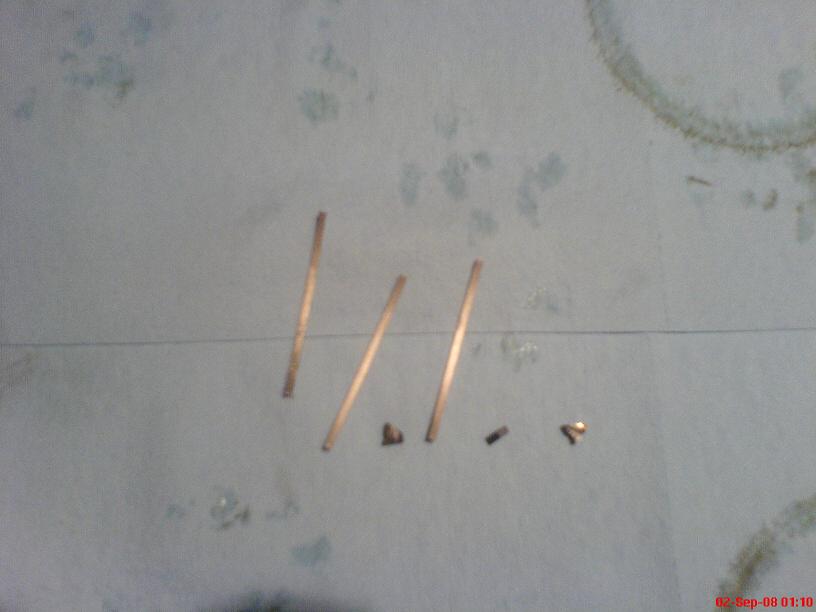
When we go to build the engine, the corner seals will be removed from the rear face of the rotor, the apex seal springs will be pushed into place, the corner seals will be reinstalled and the side pieces will be put into place.
I may use a dab of crazyglue to glue the side pieces to the apex seals, since I've heard they can be a little finicky. My side pieces in particular are worn down and many of them have worn more than the apex seal they're attached to, making for a not-so-snug fit. I'll have to be careful since if the side pieces aren't seated properly you'll end up with a LOT more compressed air/fuel blowing by the apex seal than you'd like. Possibly enough to prevent the engine from running!
But we'll cross that bridge when we get there. For now the rotors are done, the post is made, it's 3am and I've got work in 4hrs, so I'm going to bed!
Jon

When we go to build the engine, the corner seals will be removed from the rear face of the rotor, the apex seal springs will be pushed into place, the corner seals will be reinstalled and the side pieces will be put into place.
I may use a dab of crazyglue to glue the side pieces to the apex seals, since I've heard they can be a little finicky. My side pieces in particular are worn down and many of them have worn more than the apex seal they're attached to, making for a not-so-snug fit. I'll have to be careful since if the side pieces aren't seated properly you'll end up with a LOT more compressed air/fuel blowing by the apex seal than you'd like. Possibly enough to prevent the engine from running!
But we'll cross that bridge when we get there. For now the rotors are done, the post is made, it's 3am and I've got work in 4hrs, so I'm going to bed!
Jon
Last edited by vipernicus42; 09-11-08 at 01:59 PM.
#9
Viper - you thoughtful Bastid!! I am JUST today getting my 12a rotors ready to re-assemble. Talk about great timing! THANKS for the efforts. Everything you have pretty much jives with the Atkins 13b rebuild DVD I'm using. Tho the trick of installing the apex seals, corners, THEN later installing the Apex SPRINGS is a new one on me. I'm reusing my springs too, so i hear you about making sure they go back EXACTLY where they came from.
Something the Atkins DVD suggests is:
to keep the apex assys in place WITH springs, wrap an elastic band OR an old housing water o-ring around the circumference of the rotor to keep all Apex stuff in place for re-insertion of rotor into engine cavity.
Man this thread should NOT be in the Non-Tech area. This IS tech!!
Thanks again-
Stu Aull
80GS
Alaska
Something the Atkins DVD suggests is:
to keep the apex assys in place WITH springs, wrap an elastic band OR an old housing water o-ring around the circumference of the rotor to keep all Apex stuff in place for re-insertion of rotor into engine cavity.
Man this thread should NOT be in the Non-Tech area. This IS tech!!
Thanks again-
Stu Aull
80GS
Alaska
#10
Thanks for doing this Jon, very useful. I have a question for you; How freely do your apex and side seals move in their grooves? I too broke a bunch of side seals taking things apart and am in the middle of cleaing the rotors, how easily is everything supposed to move? I don't want to make things too loose....
#11
Terrified.
A+ write up, Jon. If this would have happened a few weeks ago it would have saved me a bit of the hassle of trying to get the apex seal springs in before putting the housing over the rotor (Yes, my 12A is finally rebuilt for those of you who remember me as Normality_Glitch). Waiting for an oil line and my car will finally (after years of sitting) be running again.
#13
Nicely done Jon. 2 points I'd like to make is: Glue the apex seal and assist piece before assembly starts, then install the seals, wrap a rubber band around the rotor, insert the springs. Use a small, (jeweler's), screwdriver to push them down into place until they snap/click into place. Then install the top corner seals. Rotor can than be dropped into the housing, allowing the rubber band to slide up as the rotor drops in.
As a bonus, the following is Judge Ito's clearance spec recommendations that he uses for his engine builds.
My Specs. I hope it helps everybody out a little. This specs have proven reliability and performance. For my Naturally aspirated engines I like a very tight fit with every single seal. Since N/A engine depend so much on compression and vacuum to make power I pay close attention to a tight fit. For Turbo, super charged and Nitrous engines I have different clearances. When I clearance an engine with a power added like turbo or nitrous I keep in-mind that this engines is getting artificially increased compression or twice as much more oxygen in comparison to N/A engines. In return I clearance with a bit more GAP then N/A engines. I try to allow more of a leak down from the clearance for turbo charged engines then N/A. With this leak down(from a slightly bigger GAP) for turbo and nitrous engines, I have found some reliability. Imagine if the engine does not have somewhere to leak some compression from a 35lbs boost engine, with out this sligthly bigger GAP, the engine is under some serious pressure on apex seals,corner seals and side seals and the posibility for broken seals are present.
With this explanation Ill give away some of my specs that have worked incrediable for me.
1)N/A engines. I clearance my apex seal to rotor groove to a .002 thousand of an inch. metric measurement is .051mm. Sideseal to rotor groove .0015 thats a thousand and a half, metric measurements is .028mm Sideseal to cornerseal I use, .002 of an inch. Metric is .051mm. Apex seal to rotor housing width I like keeping my apex seals .0015 to .002 smaller then the rotor housing with. This will give a tight fit for N/A engines with some really good vacuum. Pulling about 14 to 15 and sometimes 16 inches of vacuum.
2) turbo,nitrous engines.
Apex seal to rotor groove to .002 of an inch. metric is .051mm. Sideseal to rotor groove is a bit larger then N/A at .002 instead of .0015. Sideseal to Cornerseal I use .003 thousands of an inch .076mm.(DRAGON THE HOLE SECRET HERE IS TO MAKE SURE YOU HAVE .003 OF AN INCH ON EVERY SINGLE SIDESEAL TO CORNERSEAL GAP. THE WAY I DO THIS IS VERY SIMPLE, I MAKE SURE MY .003 OR .076MM FEELER GAUGE RUNS SMOOTH BACK AND FORTH THROUGH MY GAP BUT MY .004 OR METRIC 102MM FEELR GAUGE DOES NOT AND CANNOT PASS THROUGH MY .003 GAP THIS WAY YOUR SURE TO HAVE .003 ON EVERY SINGLE SIDESEAL ON BOTH ROTORS AND GIVING YOU EQUAL COMPRESSION.) it takes time but the benefits are well worth it. Apex seal to rotor housing width I like to stay .0015 to .002 smaller then the rotor housing width. I hope you guys have noticed a slightly bigger gap for turbo and nitrous engines, this has brought me some serious reliability and performance.Just an example I had one engine running 36lbs of boost and a 150nitrous oxide shot all together for 2 hole drag racing seasons and did not take the engine apart. On every single brutal run the engine came back like it was never abused. Fresh and ready for more. I have alot more sucess stories, but you guys get my point.
As a bonus, the following is Judge Ito's clearance spec recommendations that he uses for his engine builds.
My Specs. I hope it helps everybody out a little. This specs have proven reliability and performance. For my Naturally aspirated engines I like a very tight fit with every single seal. Since N/A engine depend so much on compression and vacuum to make power I pay close attention to a tight fit. For Turbo, super charged and Nitrous engines I have different clearances. When I clearance an engine with a power added like turbo or nitrous I keep in-mind that this engines is getting artificially increased compression or twice as much more oxygen in comparison to N/A engines. In return I clearance with a bit more GAP then N/A engines. I try to allow more of a leak down from the clearance for turbo charged engines then N/A. With this leak down(from a slightly bigger GAP) for turbo and nitrous engines, I have found some reliability. Imagine if the engine does not have somewhere to leak some compression from a 35lbs boost engine, with out this sligthly bigger GAP, the engine is under some serious pressure on apex seals,corner seals and side seals and the posibility for broken seals are present.
With this explanation Ill give away some of my specs that have worked incrediable for me.
1)N/A engines. I clearance my apex seal to rotor groove to a .002 thousand of an inch. metric measurement is .051mm. Sideseal to rotor groove .0015 thats a thousand and a half, metric measurements is .028mm Sideseal to cornerseal I use, .002 of an inch. Metric is .051mm. Apex seal to rotor housing width I like keeping my apex seals .0015 to .002 smaller then the rotor housing with. This will give a tight fit for N/A engines with some really good vacuum. Pulling about 14 to 15 and sometimes 16 inches of vacuum.
2) turbo,nitrous engines.
Apex seal to rotor groove to .002 of an inch. metric is .051mm. Sideseal to rotor groove is a bit larger then N/A at .002 instead of .0015. Sideseal to Cornerseal I use .003 thousands of an inch .076mm.(DRAGON THE HOLE SECRET HERE IS TO MAKE SURE YOU HAVE .003 OF AN INCH ON EVERY SINGLE SIDESEAL TO CORNERSEAL GAP. THE WAY I DO THIS IS VERY SIMPLE, I MAKE SURE MY .003 OR .076MM FEELER GAUGE RUNS SMOOTH BACK AND FORTH THROUGH MY GAP BUT MY .004 OR METRIC 102MM FEELR GAUGE DOES NOT AND CANNOT PASS THROUGH MY .003 GAP THIS WAY YOUR SURE TO HAVE .003 ON EVERY SINGLE SIDESEAL ON BOTH ROTORS AND GIVING YOU EQUAL COMPRESSION.) it takes time but the benefits are well worth it. Apex seal to rotor housing width I like to stay .0015 to .002 smaller then the rotor housing width. I hope you guys have noticed a slightly bigger gap for turbo and nitrous engines, this has brought me some serious reliability and performance.Just an example I had one engine running 36lbs of boost and a 150nitrous oxide shot all together for 2 hole drag racing seasons and did not take the engine apart. On every single brutal run the engine came back like it was never abused. Fresh and ready for more. I have alot more sucess stories, but you guys get my point.
#14
Stupid question, can you buy the assist piece seperately? I don't believe the gasket set I got from Mazdatrix has it (I didn't expect it to since it really doesn't have any rotor parts in it) BTW I was expecting to get Mazda seals since the kit costs more than the one from Atkins, but it is some unlabeled brand, very unhappy about that, I wish I had gone to Atkins instead....
Trochoid, very useful info there!
Trochoid, very useful info there!
#16
Moderator
iTrader: (3)
Join Date: Mar 2001
Location: https://www2.mazda.com/en/100th/
Posts: 30,828
Received 2,596 Likes
on
1,844 Posts
good job, thats a TON of vaseline, its going to smoke a LOT. been there =) once you've built a few you just need a dab here and there.
i read the last thread regarding the used apex seal/housing question. the engine will run, but be down on compression where the housing chrome is bad. thus it'll be down on power slightly. it would help to add more oil/premix, both to seal and for making the apex seals last longer. open question on the apexes, if you keep the revs down, they will probably last a long time
i read the last thread regarding the used apex seal/housing question. the engine will run, but be down on compression where the housing chrome is bad. thus it'll be down on power slightly. it would help to add more oil/premix, both to seal and for making the apex seals last longer. open question on the apexes, if you keep the revs down, they will probably last a long time
#17
OK, confused re : ASSIST PIECES
Are they the triangular bits that go BESIDE the apex seals, as Vipernicus's last pic seems to suggest OR are they some rubber doodad?? I had No such rubber strip come out of my 12a when I dismantled it. Haven't cracked the Gasket Kit yet to see if there is something there...
Can someone clarify what this part is?
Thanks
Stu Aull
-in middle of rebuild
Alaska
Are they the triangular bits that go BESIDE the apex seals, as Vipernicus's last pic seems to suggest OR are they some rubber doodad?? I had No such rubber strip come out of my 12a when I dismantled it. Haven't cracked the Gasket Kit yet to see if there is something there...
Can someone clarify what this part is?
Thanks
Stu Aull
-in middle of rebuild
Alaska
#23
The assist piece was a little square black piece that came bonded on the back edge of the factory apex seals. I think they were made of carbon, or something similar; they were designed to dissolve shorlty aftre first startup. You never see them on takedown, though you might find a black spot where they used to be.
There was a time where they came as a separate strip of self-adhesive material, that you had to stick on yourself (I've seen pictures).
Their job was to temporarily compress the apex seal spring, so that the little triangular end piece would temproarily drop into position behind the long apex seal, and not get shoved up on top of it and into the housing/plate joint, during reassembly.
There was a time where they came as a separate strip of self-adhesive material, that you had to stick on yourself (I've seen pictures).
Their job was to temporarily compress the apex seal spring, so that the little triangular end piece would temproarily drop into position behind the long apex seal, and not get shoved up on top of it and into the housing/plate joint, during reassembly.
#24
Moderator
iTrader: (3)
Join Date: Mar 2001
Location: https://www2.mazda.com/en/100th/
Posts: 30,828
Received 2,596 Likes
on
1,844 Posts
ah neat. ive never had a problem with that, but it is annoying when the spring pops the triangle bit across the room


